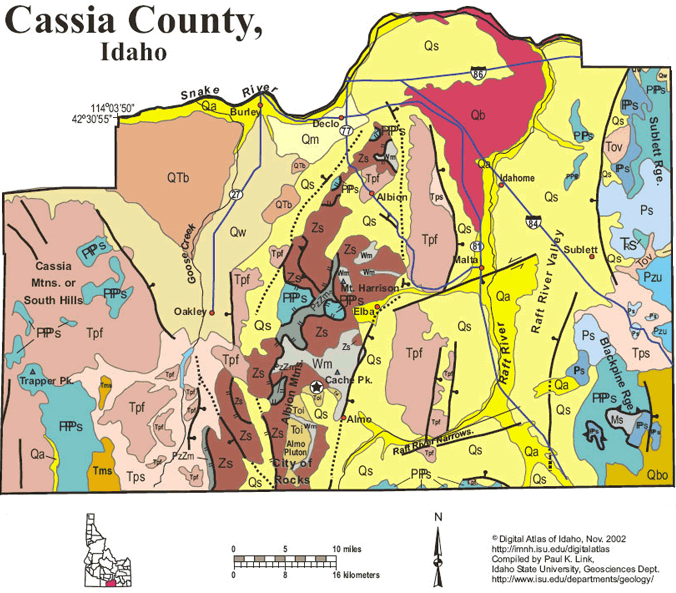
Geologic Units |
|
| Quaternary alluvial deposits | |
| Quaternary surficial cover, fluveolian cover on Snake River Plain, alluvial fans (Snake River Group) | |
| Lake Bonneville deposits | |
| Pleistocene basalt lava | |
| Pliocene and Upper Miocene stream and lake deposits (Salt Lake Formation, Starlight Formation, Idaho Group) | |
| Pliocene and Upper Miocene felsic volcanic rocks, rhyolite flows, tuffs, ignimbrites (includes Moonstone rhyolite) | |
| Pleistocene and Pliocene basalt lava and associated tuff | |
| Pliocene and Upper Miocene sedimentary rocks and intercalated basalts (Starlight Formation, Salt Lake Formation) | |
| Oligocene volcanics (Potlatch volcanics and Salmon Falls Creek volcanics) | |
| Triassic sedimentary rocks | |
| Upper Paleozoic sedimentary rocks | |
| Permian sedimentary rocks | |
| Permian and Pennsylvanian sedimentary rocks | |
| Pennsylvanian sedimentary rocks | |
| Mississippian sedimentary rocks | |
| Oligocene City of Rocks granite (about 25 Ma.) | |
| Neoproterozoic sedimentary rocks | |
| Paleozoic/Neoproterozoic metasedimentary rocks (includes formation of Leaton Gulch) | |
| Archean basement |
| Map Key | |
| Geologic units with unit designation. | |
| Normal Fault: certain; dashed where approximately located; dotted where concealed. | |
| Thrust Fault: certain; dashed where approximately located; dotted where concealed. | |
| Detachment Fault: certain; dashed where approximately located; dotted where concealed. | |
| Interstate Route. | |
| U.S. Route. | |
| State Route. | |
| Location of Rockwalk rock from the county. | |
| Cities. | |
| Feature location. |
Cassia County
Cassia County, on the south side of the Snake River forms much of Idaho's southern boundary with Utah and Nevada on the west. It contains a diverse assemblage of rocks, including the oldest rocks in Idaho, the metamorphic Green Creek gneiss in the Albion Mountains core complex.
Most of the people in Cassia County live in irrigated agricultural areas near Burley, Declo and Oakley. This area, on the southern edge of the Snake River Plain, is underlain by Quaternary basalt, including shield volcanoes visible today, overlain by windblown loess and alluvium. Thick cobble gravel derived from the Albion Range in Pleistocene time underlies the Oakley valley.
The Albion Mountains, south of Albion, and west of Elba and Almo, are one of a series of turtleback-shaped uplifts of metamorphosed middle crust that are found along the axis of the Mesozoic Cordilleran orogenic belt, generally at the location of maximum crustal thickening during compressional tectonics. They contain Archean gneiss overlain by Proterozoic Elba quartzite and Paleozoic Clarks Basin and Harrison Summit schist and quartzite, below a low-angle detachment fault. Above the fault are less metamorphosed, folded Paleozoic rocks. The Raft River Mountains, just to the south across the Utah border are a similar feature.
The Oligocene Almo Pluton, which underlies the City of Rocks, was intruded 25 million years ago into this domal uplift. The City of Rocks contains distinctive granite monoliths that were a landmark to the California Trail and are now a rock climber's playground.
The Raft River detachment fault, an east dipping structure, exhumed the Albion core complex and downdropped the Raft River Valley and the volcanic rocks of the Jim Sage and Cottrell Mountains between Elba and Malta. The U.S. Department of Energy drilled a several-thousand-foot geothermal well south of Malta in the 1980s, but the project did not demonstrate economic potential for electrical generation.
Southeast of the Raft River Valley are the Black Pine Mountains, underlain by folded and thrust-faulted Paleozoic rocks in the hanging wall of the Raft River detachment. These rocks formerly were on top of the City of Rocks area, and have been downfaulted to the east to their present location. They contain gold mineralization that was mined in the 1990s and at several previous times in the 20th century.
The Sublett Range, east of the Raft River Valley, contains thick upper Paleozoic limestones.
To the west of the Albion Range is Middle Mountain, which contains schistose quartzite that is mined for "Oakley Stone" a decorative flagstone shipped across the world. West of there, across Goose Creek, is the extensive Miocene Trapper Creek basin filled with tuffs and rhyolite ignimbrites from the Twin Falls volcanic center. The Cassia Mountains or South Hills, on the western edge of the county, contain spectacular cliffs in deep canyons, all cut from these rhyolite ignimbrites and fallout tuffs.
See several sections of text in Rocks Rails and Trails.
P.K. Link, 10/02
Additional Reading
Rocks Rails and Trails: pages
Introduction to the Geology of South & East Idaho
Introduction to Geologic Diagrams
Geologic cross sections
Relations between Geology, Topography and Drainage Systems in Idaho
Drainage and mountain range map for eastern Idaho
Table of Geologic Events in Southern Idaho
The Snake River Plain-Yellowstone Hot Spot and its Effect on Drainage Patterns
Rocks of Central Idaho
Pictures -Idaho Mountains
Challis Volcanic Group & Intrusive Rocks
References on Idaho Geology
Section 3, History of Eastern Idaho
Section 3, Chapter 8 -"Famous Potatoes" Agriculture & Irrigation
Section 4, Chapter 15 -Malad Valley & Country to the West
Section 7, Chapter 22 - Silent City of Rocks & Burley Area
![]() Click here to see a correlation
of geologic units, and the associated time scale.
Click here to see a correlation
of geologic units, and the associated time scale.
Click here for a PDF printable version of Cassia County Geologic map.
|
Click on the button below to search the IdahoGeologic
Survey's index of Geologic Maps
|
 |